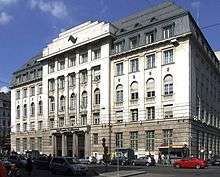Creditanstalt
|
| |
| Subsidiary of Unicredit | |
| Industry | Finance and Insurance |
| Founded | 1855 |
| Founder | Anselm von Rothschild |
| Headquarters | Vienna, Austria |
Key people | Anselm von Rothschild, founder |
| Products | Commercial banking, Investment banking, Private banking, Asset management |
| Revenue | € bn (as of 2004) |
| Website |
www |
The Creditanstalt (sometimes Credit-Anstalt,[1] abbreviated CA) was an Austrian bank based in Vienna.
History
In 1820, Salomon Mayer von Rothschild established the first bank in Vienna, then the capital of the Austrian Empire. In the course of early industrialisation, the Rothschild bank financed large development projects, such as the building of the Emperor Ferdinand Northern Railway to the Moravian mining regions. Rothschild also acted as generous lender to Austrian state chancellor Prince Klemens von Metternich and granted copious credits to the Bohemian and Hungarian aristocracy.
Austria-Hungary

The Creditanstalt was founded in 1855 by von Rothschild's son Anselm as K. k. priv. Österreichische Credit-Anstalt für Handel und Gewerbe (approximately translated, Imperial royal privileged Austrian Credit Institute for Commerce and Industry). Being very successful, it soon became the largest bank of Austria-Hungary.
Anselm's son, Albert, took control of the Credit-Anstalt in 1872, succeeded by Louis de Rothschild in 1911. In 1912, the new headquarters in Vienna's Innere Stadt opened in a lavishly decorated Neoclassical building, which is still preserved to the present.
First Republic
The business situation dramatically changed with Austria's defeat in the First World War and the dissolution of the Austro-Hungarian monarchy and empire. In the late 1920s, a principal debtor, the Steyr-Werke AG faced financial difficulties, with bad loans leading to a drain on finances. In October 1929, the Schober government compelled the allegedly well-financed Credit-Anstalt to assume liabilities, which together with the simultaneous Wall Street Crash led to the financial imbalance of the then-largest Austrian credit provider.
Creditanstalt had to declare bankruptcy on 11 May 1931. This was one of the first major bank failures that initiated the Great Depression.[2]:2–3 [3][4] Chancellor Otto Ender rescued Creditanstalt by distributing the enormous share of costs between the Republic, the National Bank of Austria and the Rothschild family. Nationalization plans advanced by the Social Democrats were rejected. However, the institute was de facto state-owned after Chancellor Engelbert Dollfuß in 1934 ordered the merger of the institute with the Wiener Bankverein, thus changing its name to Creditanstalt-Bankverein. The Creditanstalt bankruptcy and its impact in producing a major global banking crisis provided a major propaganda opportunity for Adolf Hitler and the Nazi Party: it allowed them to further blame Jews for German and international economic and social troubles .
Following the Austrian Anschluss to Nazi Germany in 1938, Creditanstalt-Bankverein was targeted for both financial and racial reasons. Louis de Rothschild was immediately arrested and imprisoned for the losses suffered by the Austrian state when the bank collapsed. Deprived of his position and property, he emigrated to the U.S. in 1939 after more than one year in custody.
Creditanstalt-Bankverein was later taken over by Deutsche Bank,[5] patronized by Hermann Josef Abs. Though CEO Josef Joham made contact with the Office of Strategic Services, Creditanstalt also settled the financial issues of several Nazi concentration camps as well as the "Aryanization" of Jewish-owned businesses, like the re-establishment of Sascha-Film as Wien-Film Limited.
Second Republic
After World War II, the bank was finally nationalised by Allied-occupied Austria in 1946 and became mainly a commercial bank and highly involved in Austria's economy, holding stakes in important Austrian companies such as Wienerberger, Steyr-Daimler-Puch, Lenzing AG and Semperit. From 1956 onwards, Creditanstalt was again partly privatised by issuing 40% shares, though only 10% common stock.
In 1981, the former Social Democratic Minister of Finance Hannes Androsch assumed the office of a general manager, after he had left the Kreisky cabinet. Industrial interests were reduced, while the government ownership share fell to 51%. In the 1980s, Creditanstalt opened branches in London, New York and Hong Kong, while the international orientation towards East-Central Europe was boosted by the fall of the Iron Curtain upon the Revolutions of 1989. Nevertheless, after several difficult lending operations, Creditanstalt became an acquisition candidate.
In 1997, the state-owned shares were sold to Bank Austria (BA), resulting in a crisis in the ruling coalition between the Social Democratic Party and the conservative Austrian People's Party, since Creditanstalt had to be considered part of the conservative sphere of influence, whereas BA with its roots as Red Vienna's Central Savings Bank (Zentralsparkasse) was considered standing politically left. The merger was not finished until 2002, with the creation of Bank Austria Creditanstalt (BA-CA), which became part of the German HypoVereinsbank (HVB) group. In 2005 HVB was taken over by the Italian holding company UniCredit. After 153 years, the bank name Creditanstalt was finally erased in 2008, but survived in the CA Immo subsidiary.
References
- ↑ "Plugging the hole". The Economist. 2010-11-25.
- ↑ Moessner, Richhild; Allen, William A. (December 2010). "Banking crises and the international monetary system in the Great Depression and now" (PDF). BIS Working Papers. Bank for International Settlements (333). ISSN 1020-0959. Retrieved 2011-07-25.
- ↑ "Potential for black swan 'Credit Anstalt' event," Variant Perception, 10 May 2010
- ↑ Martin Wolf (2012-06-05). "Panic has become all too rational". Financial Times. Retrieved 2012-06-07.
- ↑ MacDonogh, G (2009). 1938: Hitler's Gamble. New York: Basic Books. pp. 49, 69.
Literature
- März, Eduard, Austrian Banking and Financial Policy: Credit-Anstalt at a Turning Point, 1913–1923 (Basingstoke: Palgrave Macmillan, 1984) ISBN 978-0-312-06124-1
- Schorske, Carl E., Fin-de-Siècle Vienna: Politics and Culture (London: Vintage, 1980) ISBN 0-394-74478-0
- Schubert, Aurel, The Credit-Anstalt Crisis of 1931 (Cambridge: Cambridge University Press, 1992) ISBN 0-521-36537-6